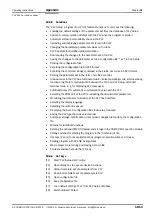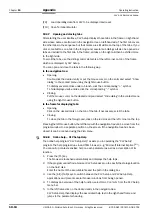
Operating Instructions
Chapter
10
CLV 42x bar code scanner
Appendix
8 009 981/O078/16-08-2004
©
SICK AG · Division Auto Ident · Germany · All rights reserved
10-19
10.5.2
Profile programming
Profile programming uses special bar codes to parameterize the CLV via the optical
interface (reading window). The profile bar codes contain encoded parameter values. It is
not necessary to connect a PC to the CLV in order to carry out profile programming.
The profile bar codes are presented to the CLV individually for reading. It copies the
parameter values to the current parameter set.
The changes are permanently valid after programming has been completed; in some cases,
they also have an immediate effect on the reading and output characteristics of the CLV.
The profile bar codes can be presented to the CLV either immediately after the power supply
has been switched on, during the wait time in the Free Running mode or during a reading
pulse in the Reading mode. During profile programming, the CLV does not output a reading
result and does not respond to an external reading pulse.
Profile bar codes are created and printed via the user interface of CLV Setup after the
application-specific parameter set has been compiled
(Section"Printing profile bar codes"
The enclosed card no. 8 008 085 ("Configuration Profiles for CLV 41x Bar Code Scanners")
contains 12 preprinted profile bar codes. They can be used to parameterize tested settings
or to trigger specific functions (e.g. AutoSetup). The meaning of the individual profile bar
codes is explained in
. Profile bar codes no. 11 and no. 12 on the
card are of no significance for CLV 42x.
Preparing profile programming
1.
Profile programming overwrites values in the current parameter set of the CLV.
If the CLV has already been configured for a particular application, it is advisable to save
the existing parameter set as a configuration file "*.scl" in CLV Setup.
Chapter 6.4.1 Configuring CLV with the user interface of CLV Setup, Page 6-4
.
2.
Have the printed profile bar codes of the compiled parameter set or card
no. 8 008 085 ready. Or print the bar codes of the card no. 8 008 085 as PDF file from
the CD-ROM („Manuals & Software“). To do so, select the “Programming Profile Bar
Codes“ folder in the list on the top left of the start page.
Performing profile programming after switching on the power supply
1.
Switch on the power supply of the CDB 420/CDM 420 connection module (of the CLV).
The CLV confirms that the self-test has been completed successfully by outputting a
tone via the beeper. The "Device Ready" LED lights up. It then switches to the Free
Running mode for
5 seconds
. The red scan line appears when the "Laser On" LED lights
up.
2.
Present the first profile bar code in the printed sequence (or the desired profile bar code
from the card) within 5 seconds. Fold the printout/card in such a way that only one
profile bar code is visible at any one time.
The CLV confirms that the bar code has been read successfully by outputting a tone via
the beeper and waits
10 seconds
for the next profile bar code.
It copies the new parameter value(s) to the current parameter set in the RAM.
3.
Present the next profile bar code within 10 seconds.
The CLV confirms that the bar code has been read successfully as described in Step 2.
4.
Allow 10 seconds to pass after the last profile bar code has been read.
The CLV exits the programming mode and saves the new parameter values
permanently in the EEPROM. It also switches off the laser diode. Following this, it returns
to the Reading mode and confirms this by outputting two consecutive tones via the
beeper. The "Device Ready" LED lights up.















































